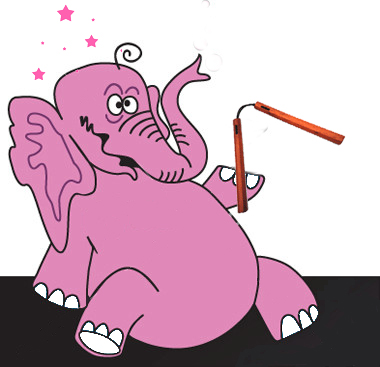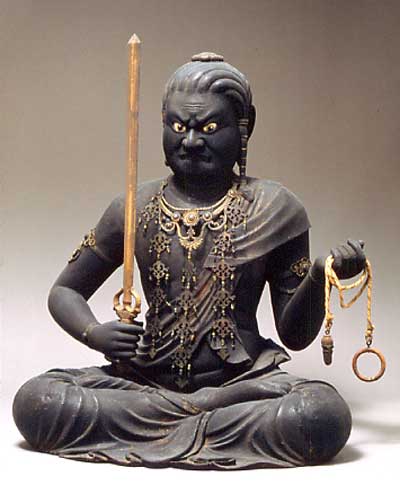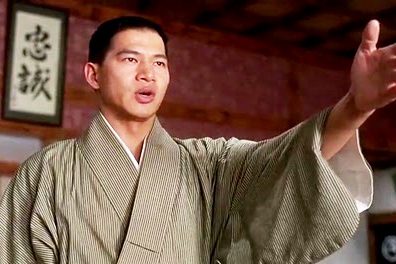Disclaimer: This post is heavily based on written content and contains no images whatsoever.
Nevertheless, since I realize that images are important for learning – especially for visual learners – I have drawn my own image, depicting a drunk, pink elephant banging himself in the head with a nunchaku, below.
During the course of reading this article, whenever you feel an urge for immediate visual input – please, don’t hesitate to scroll up to this pink, drunk elephant banging himself in the head with a nunchaku, and observe it for approximately 10 seconds (+/-5 s). Research suggests this procedure should be repeated every 20th paragraph read, but individual preferences should be taken into account.
Enjoy the article, starting below the image.

I sometimes get a feeling that some people (mainly beginners) find Karate too technical and maybe over-focused and obsessed with seemingly trivial details.
“Who cares if my elbow points here or there, I can still knock him out, dude!?”
Well, depending on who’s teaching it, and depending on what stage (in your training) you’re at, Karate can – or can not – be very, very technical.
I know some people who are for ever stuck in details.
Poor souls…
Anyway, the interesting part about details is that though they sometimes, to the untrained eye, may seem like totally separate issues, all correction and improvement of details serve the very same purpose, since the body in the end functions and acts as a unit.
That means; changing in one end surprisingly often changes the other end too.
To care about details is to care about identifying and eliminating waste (in Japanese: muda), remove overburden (Japanese: muri) and get rid of inconsistency (Japanese: mura).
These are the three M’s of Karate.
The three M’s that every Karate-ka should strive to identify and exterminate, because together they form something of an evil, dissonant triad.
All three M’s must be eliminated to create perfect harmony between technique, mind and body.
So let’s break them down:
Muda
Muda, made up of the ideograms representing “none” + “burdensome”, literally means waste, or something that is unproductive.
A Japanese example sentence would be: “Jikan no muda desu yo!” (You’re wasting your time!”).
In Karate, muda is all activities that do not add value from a outcome-based perspective and thus can be removed. Of course, this presumes that you already know the aim of the technique or movement in question.
To use a very basic example (I’m confident that you can come up with a better one) let’s take a stepping punch.
Call it oi-zuki, jun-zuki or whatever you want.
A common muda mistake that many people repeat in this movement, is if you would slightly (often unconsciously) adjust your front foot just before lunging forward. This small adjustment of the foot is muda, waste, and must be removed. It serves no real purpose, except if you have been training incorrectly.
Other common muda include such classics as raising the shoulders, or tensing the fist too tight.
Muri
Muri, made up of the ideograms representing “none” + “logic”, literally means unreasonable, or overburden/overdoing.
An example sentence in Japanese could be: “Saikin muri wo shite imasen ka?” (“Are you overworking yourself lately?”).
In Karate, muri is when you try to do everything at the same time, putting too much strain on the system, resulting in failure. Muri is simply not following the logical order of movement (also, think internal vs. external) in a technique.
Let’s use the stepping punch again.
What part of the body do you move first?
The head? The shoulders?
Your elbow!?
For greatest economy of movement, initializing the stepping punch through the back leg, buttock and shooting the pelvis/hip forward in an arching movement is what most instructors would agree is the optimal way. Only then can the head, shoulders and rest of the body be propelled forward and hurled into the object receiving your (hopefully) devastating blow.
Muri is about being smooth, and doing things the logical way.
If you want a real head scratcher considering muri, look at people’s kicks.
Mura
Mura is, unlike Muda and Muri, only written with one kanji, meaning “unevenness” or “inconsistency”.
A sentence might sound like the following: “Kono gakusei no seiseki ni wa, mura ga arimasu.” (“This student performs unevenly on his tests”).
In Karate, mura is maybe the easiest one to spot, and for an untrained eye it might be the only one of the three M’s spotted!
Unevenness, mura, can often be such basic things (but when I think about it, aren’t muri and muda also quite basic?) as stances. A perfect example is the kata Suparimpei (considered The Holy Grail of Goju-ryu) which consists almost exclusively of sanchin-dachi and shiko-dachi, making it perfect for mura thrill-seekers.
Another, more advanced way, of looking at mura is in inconsistencies not only in the starting/ending positions, but also in the flow of techniques. Is the flow even throughout the movement, or is it impeded along the way?
(I won’t even use the stepping punch as an example because I know you already get the point!)
___
So, to sum it up: To establish an economic – and ultimately effective – technique, eliminating the three M’s (preferably in a systematic fashion) is mandatory.
It must be done.
The sooner the better – because new details can’t surface unless the old ones are gone.
The technique is hence incrementally and continuously improved, which is known as “kaizen” (“continuous improvement”) in Japanese, and is reflected in our dojo-kun (“seeking perfection” and “endeavouring”).
The three M’s are what every Karate class should be about.
Or rather, not be about.
Eliminate muda, muri and mura both in your techniques (through kihon, kata and kumite), in your body (through hojo-undo and taiso) and in your mind (through seishin tanren), and one day you might even be able to reach the peak of the Mountain of Self, which we are all in the end climbing, through the way of Karate.
Or through some other way.
No matter what way, there is still only one moon to be seen for those who reach its summit.
But like Bruce Lee warned us (in Enter The Dragon), when you finally stand on top of that mountain and point to the moon, don’t concentrate on the finger…
Or you will miss all of the heavenly glory.



3 Comments